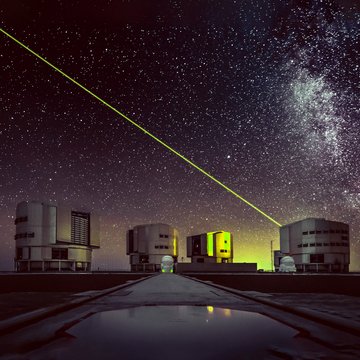For Measuring Beyond Borders - 384,403 km to the Moon
HARDLY ANY OTHER TOOL CAN MEASURE DISTANCES AS PRECISELY AS A LASER.
WHAT BEGAN IN SPACE SOME 50 YEARS AGO, CAN NOW BE FOUND IN EVERY CAR.

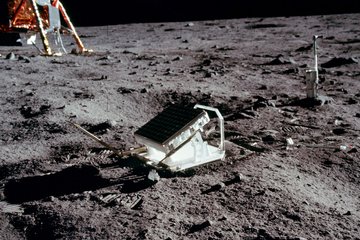
384,403 km to the Moon
When Theodore Maiman introduced the first laser in 1960, he described it as a »solution in search of a problem.« Just a few years later, the first laser beams were used to monitor the trajectory of satellites. Reflectors from those early days are still in use today – on the Moon!
When Neil Armstrong and Buzz Aldrin set foot on the surface of the moon on July 21, 1969, they carried with them a piece of luggage that continues to provide valuable services to science today: a retroreflector with a hundred individual prisms. To this day, it stands some 384,403 km from the Earth in the Sea of Tranquility. We know this precisely because its only task is to measure the distance between our planet and its satellite. In technical jargon, this is called lunar laser ranging (LLR). Even more than 50 years after the first moon landing, scientists regularly send laser beams to the moon and the reflector dutifully sends the light back again.
Picture: The first retroreflector was installed on the lunar surface in July 1969 by astronauts on the Apollo 11 mission. Astronomers from around the world use it to measure the exact distance between the Earth and the Moon.
Only a few photons make it »home«
Beyond Borders

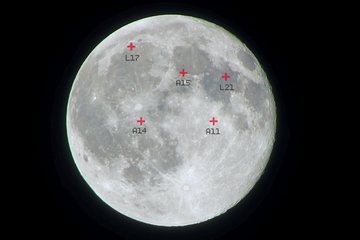
With the retroreflector, scientists were able to determine the distance to the moon to within a few centimeters in 1969. The basic principle is relatively simple: The researchers stopped the time between the generation of the laser pulse and the moment when the reflected beam hit the sensor. Since light always travels at the same speed, they were able to determine the distance using simple fractional arithmetic. This method is still used in all laser distance meters today.
However, the whole thing is not quite so trivial because the laser passes through the atmosphere twice on its way. In the process, the light is scattered quite a bit. Ensuring that at least one of the hundred quadrillion photons makes it back requires a correspondingly large amount of laser power, as well as a detector that is sensitive enough to detect this lone photon. Therefore, there are only a few telescopes worldwide with which it is possible to achieve such measurements.
Picture: Locations of the retroreflectors of the Apollo 11
... and Einstein was right after all!
Beyond Borders

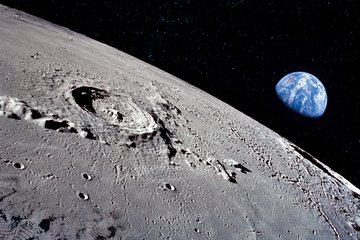
Many are now asking, »Why go to all the effort?« As it turns out, lunar laser ranging has given researchers valuable insights into the interactions in the Earth-Moon system. For example, we now know that the moon moves about four centimeters away from Earth each year. ... and LLR was even able to provide practical proof of Einstein’s theory of relativity. According to this theory, the Earth and the Moon would have to move through the Sun’s gravitational field with identical acceleration, even though their own gravitational fields differ greatly. This is exactly what the measurements confirmed, and for this reason alone the trip to the moon was worthwhile.
Yesterday on the moon
TODAY IN THE HARDWARE STORE
LLR was only the beginning. The real triumph of the laser began shortly afterwards, when in 1970 semiconductors were used for the first time to generate laser beams. This success set in motion a miniaturization trend that continues to this day. Today, you can buy a handheld device in any hardware store that basically does nothing more than the giant lasers of 1969.
New dimensions
The next step is referred to as light detection and ranging (LiDAR). As the name suggests, LiDAR adds a crucial element to classic distance measurement: detection. LiDAR detects objects and determines where they are in a space. Instead of just measuring the distance between two points, thousands of laser pulses scan the entire environment in a fraction of a second. They create a cloud of points that a computer transforms into three-dimensional images. Because the individual pulses follow one another quickly, LiDAR can also detect movement and use it to calculate the speed of vehicles, for example.
LiDAR on the road
Beyond Borders

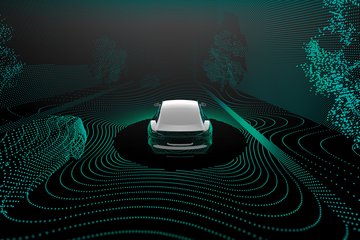
LiDAR makes roads safer
The best-known example of such speed measurements is the »speed gun« used by the police. Strictly speaking, most speed traps today are LiDAR traps. The effect is the same and if we are honest, they make a significant contribution to road safety. So does another LiDAR system, which is housed in the car itself: emergency brake assist. This is where LiDAR’s capabilities really come into their own, as the vehicle independently detects obstacles, measures the distance, and initiates braking if necessary. Insurance companies predict that these assistance systems will reduce the number of traffic accidents by 20% to 30%.
The challenge of the future
Many see driver assistance systems as the first step toward self-driving cars, and indeed it is not only car manufacturers who are currently working on this vision of the future. LiDAR will certainly play a crucial role in this development, but the requirements are enormous. First of all, the range and resolution of these systems must increase. For components manufacturers such as LASER COMPONENTS, this means the following advancements are necessary: laser diodes with even shorter pulse durations and even higher output power, as well as even more sensitive detectors – and both should ideally be so small that they can be installed anywhere in the car.
Picture: LiDAR creates a three-dimensional image of the environment
Creative solutions for tomorrow
Beyond Borders
Creative solutions for tomorrow: The vision of the self-driving car is currently one of the most important innovation drivers in the laser industry. The development engineers at our locations in Canada and the USA are working at full speed on creative solutions to make this dream come true. At LASER COMPONENTS Canada, for example, they have achieved a breakthrough in microproduction that has enabled them to significantly improve the efficiency of our pulsed laser diodes (see pg. 27).
Tiny »trenches« between the circuits of the emitters avoid annoying interference currents and thus ensure higher output power. This will enable LiDAR systems to »see« even further in the future. This is another important step toward autonomous driving, but the goal is far from being achieved. Further innovations are already in the pipe.

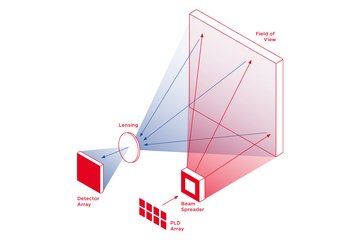
Flash LiDAR: With powerful emitters and highly sensitive detectors, LiDAR systems can be implemented without moving parts.


»WE ARE WORKING TO MAKE ONE OF THE GREAT FUTURE VISIONS OF OUR TIME A REALITY.«
JEFF BRITTON / Former General manager of LASER COMPONENTS Canada (2003-2023)
LASER COMPONENTS CANADA
The general manager, Jeff Britton, and his team are working on pulsed laser diodes for self-driving cars. The challenges can be met with two different approaches: either with ever-shorter pulse durations, as in QuickSwitch® PLDs, or with arrays that house four to twelve emitters on a single chip.

